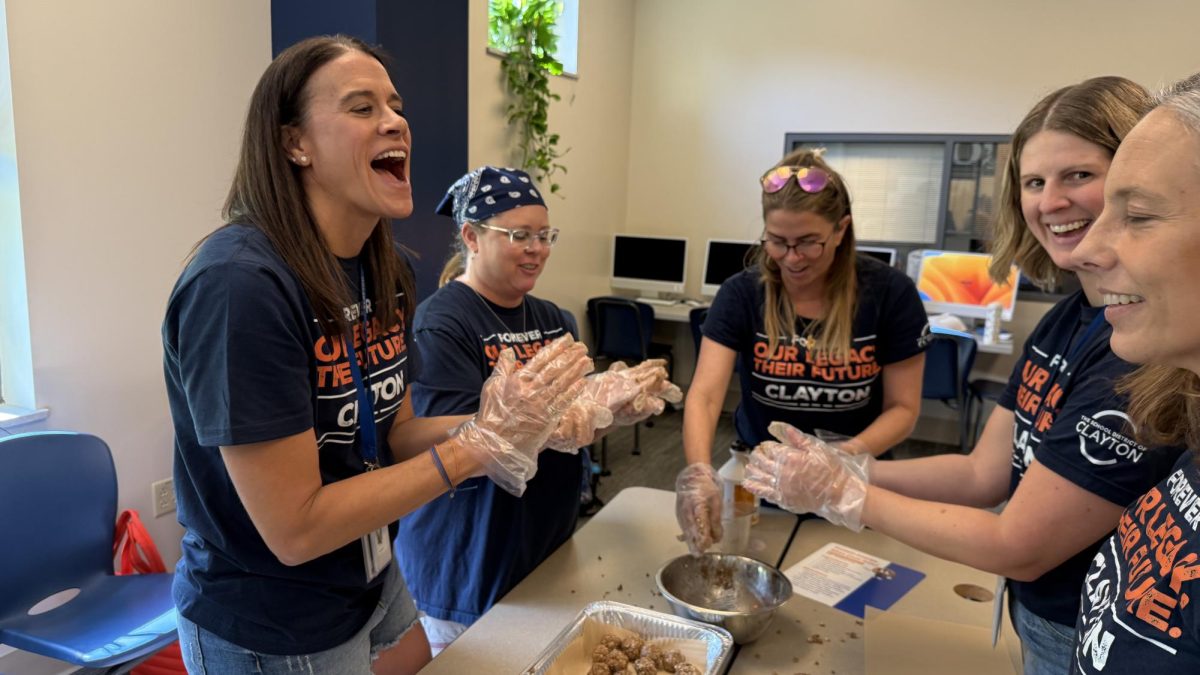Tickle My Pickle: The Pickle-Making Population of Clayton
October 15, 2015
Tickle My Pickle: The Pickle-making population of Clayton
Catherine Walsh and Mia Redington
“I usually start at 7 in the morning and I’m not done till 10 at night. It’s an all day process for me. I have to be really committed to this process,” Said Mrs Shagrin.
Shelby Schagrin and Kristin Stahl, parents of CHS alumni, have learned the art of pickling.
“I wanted to save the season’s bounty of cucumbers. Is that cheesy enough?” Stahl said. “Actually my grandmother also used to do it, and my grandfather told me my grandma used to sell bread and butter pickles, so out of nostalgia I wanted to start [pickling].”
Schagrin has wonderful access to an organic garden.
“My husband grows the pickles, he’s a great gardener,” Schagrin said. “Sometimes if I put garlic in [my pickles], he grows it, but most of the time he doesn’t.”
The women have learned a variety of ways to enjoy their pickles.
“A ham sandwich, that’s really good,” Stahl said. “The other night we had it with a little gouda cheese and those little crackers with a pickle on top.”
“I could put them on anything,” Schagrin said. “Like, any sandwich – cheese sandwich, hamburgers or hot dogs, I could put them on salmon, I could put them on a piece of toast with cream cheese, I could put them with peanut butter. Literally anything. They’re really, really, really delicious.”
Both women practice pickle-making as just a hobby.
“Right now I am thinking of just giving them out as Christmas presents,” Stahl said.
“One of the other things that makes my pickles really really great is my labeling system. I have everything labeled, and these pretty little glass jars that I put them in. So it’s the whole process that just makes it really special… I only [pickle] once or twice a year, because it’s such a big deal. But I make a lot… Everyone begs me for them,” Schagrin said.
However, the pickles are not easy to make.
“It’s a really big process, it takes all day to make them, and it’s really complicated, because first you have to cut all of the cucumbers. They have to be Persian cucumbers. And then you have to put them in a brine for 5 hours, so it’s a salt-ice mixture… And then when all that’s done you have to start the pickling process, and after that you have to do the canning,” Schagrin said. “So the whole process ends up taking, like, 7 or 8 hours.”
“They’re sweet pickles, it’s like, beyond delicious,” Schagrin said. “So it became kind of my signature thing. But it’s a really big process, it takes all day to make them, and it’s really complicated.”
Although Schagrin claims that she is not a good cook, her friends and family would beg to differ.
“We have a friend in New York, and something happened that was a little bit bad. So I sent them all these pickles to New York, and they really loved them and it made them feel really good,” Schagrin said. “Also, I have this son-in-law that I send pickles to, who I’m crazy about, and he loves my pickles so much, so I kind of give my pickles to people all over.”
“Everyone always asks me to make a business [out of my pickles], but it wouldn’t be a good business,” Schagrin said. “I just give them to the people I care about.”
Schagrin describes: “It’s a really big process, it takes all day to make them, and it’s really complicated, because first you have to cut all of them- cut all of the cucumbers, they have to be Persian cucumbers. And then you have to put them in a brine for 5 hours, so it’s a salt-ice mixture… And then when all that’s done you have to start the pickling process, and after that you have to do the canning. So the whole process ends up taking, like, 7 or 8 hours…”
The process of pickle-making is easier said than done. In order to make the perfect batch of pickles, it is necessary to buy or grow cucumbers made for pickling. These cucumbers are then cut into one-fourth inch slices, along with the onions. After cutting them both, the cucumbers and onions are placed into a giant pot and mixed with pickling salt, and on top three to four inches of ice are put on the mixture. This step is called icing, which takes at least three hours (or up to twenty-four hours) before spices and vinegar are added to the cucumbers and onions.
After the icing is completed, the cucumbers and onions are rinsed off, and drained of the salty water. Finally, the spices and vinegar are added to the soon-to-be pickles. In a separate stock pot, the vinegar, sugar, mustard seeds, celery seeds, pickling spice and turmeric are put in to boil. The cucumbers and onions are then poured into the spice mix and stirred evenly so as to evenly coat the cucumbers; then the mixture is left to boil for a minute. In the meantime, the jars must be sterilized; one way is to wash them out with hot water and let them air out for fifteen to twenty minutes.
Once the jars are taken out of the oven, the cucumber-spice mixture can be ladled into the jars, and the lids shut tightly. However, this is not the last step. All of the jars must be put into pots with water and filled up so that the water is above the lids, and wait for the water to boil. Once the water starts boiling, ten minutes must be allowed before taking the jars out of the pot. When the jars are out of the water, they must cool down before they are labeled. Once labeled, that jars are kept in a dark cool place for three weeks or up to a year.
Despite the tedious process, both women agree that pickle-making is a labor of love that Schagrin has performed for 10 years, and Stahl who just started this year. Their work inspires the rest of the community to become involved in a unique, beneficial hobby.





![“I love working with students, that's why I decided on being a high school teacher. I was going to go the University route, but it's a different feel[ing]. Working with students is what makes it fun, keeps it alive, keeps me, trying to connect with students about my passion with ancient Rome and Greece and how they overlap, and how the stuff we do in class impacts their lives. That's kind of the goal I have, is having them see themselves, students in this larger scope of history from 2000 years ago, and how you're part of that now. ”
- Matthew Crutchfield, CHS Latin teacher](https://www.chsglobe.com/wp-content/uploads/2025/09/image2-3-e1757531718144-1200x872.jpg)
!["It's really hard to make friends in Clayton high school if you're a newcomer. Everybody already knows each other, and they have established friendships for many years. My goal is always to make my space a safe one for them to take risks, [and] relax." Nancy Gamble, English Language Specialist](https://www.chsglobe.com/wp-content/uploads/2025/09/image1-e1757625469759-1200x843.png)



